
The Best Way to Reheat Pizza
There’s nothing like a freshly baked slice of pizza. The warm sauce, the delicious toppings, and the crunchy crust is sure to please everyone. But does the thought of leftover pizza do little to stimulate your appetite? If so, then you’re not alone. Many pizza lovers dread the taste and feel of a cold, leftover slice. As a result, several reheating methods have been developed. But which one is the best? To help you answer this question, I’ve created this article to find the best way to reheat pizza. I’ll cover the three main methods and try them out for myself. I’ll also list some of the other ways people reheat pizza. At end, I’ll rank the methods based on their effectiveness as well as the pros and cons for each.
My methodology
To test out each method, I ordered two medium pizzas from Panago: the BBQ Bacon Chicken and the True Canadian. Both pizzas had meat toppings, and only the BBQ Bacon Chicken had vegetables (red peppers). Using all the restraint and will power in me, I placed a few slices in a plastic bag and refrigerated them overnight. I also packed up the remaining slices into tuber ware containers. I tested each method using slices from both pizzas.
Before you begin
While most pizzas will taste great when reheated, there are some caveats. According to The Pioneer Woman, pizzas topped with fresh greens like spinach or arugula do not fare well when reheated. These vegetables will wilt and dry up when you reheat the pizza. Take into consideration the toppings on your pizza before you reheat it. If you think the topping won’t reheat well, then you might have to eat the leftover slice cold or at room temperature. Thankfully, pizza is the one food where it still tastes delicious when eaten cold.
Another thing you should be careful with is heating the pizza too fast. Cooking it at an extremely high temperature gets the job done quickly, but the pizza may get burned. That’s why the low and slow cooking method is the ideal way to reheat cold pizza. You’ll get even heat distribution, which will make your pizza taste like it was freshly made.
Main methods
The microwave
Reheating pizza in the microwave is probably the method most people use. I have always used the microwave to reheat slices. It’s quick and convenient; it takes no longer than three minutes. However, microwaves do a poor job of recreating the pizza’s crispiness. Anyone who has reheated leftover in the microwave is all to familiar with the soggy slices you get in return. Plus, the crust quickly becomes rock hard and tough to chew.
So why does this happen? It all comes down to how microwaves work. The energy produced by the microwave heats the water molecules found in food. Therefore, water molecules in the pizza are drawn out. They are quickly heated and evaporate, which causes a steaming effect. That’s why the slice becomes soggy. And since there is no sauce on the crust, most of the moisture is lost, which makes it dry and tough to chew.
As you can see, reheating leftover pizza in the microwave is not an effective approach. If you want a crispy, flavourful slice of pizza, avoid this method at all costs. But there are times when you have no other option but to use a microwave. If you find yourself in this situation (as I have on several occasions), here is a trick you can try.
According to the Spruce Eats, fill a microwavable safe mug or glass with water and place it in the microwave with a slice of pizza. The water supposedly acts a decoy, absorbing some of the energy so the slice can heat up more evenly and the crust retains some moisture. Heat on high for 30-60 seconds and constantly check the progress. You should see some improvement in the overall quality of the pizza. If you want more crispiness, you can partially heat the pizza in the microwave, then finish it off in a toaster oven. Another recommend method is to wrap the slice in paper towels. The paper will absorb most of the moisture that is evaporated from the pizza. Lastly, try setting your microwave to 40-50% power and heat the slice for 45 seconds. This prevents the pizza from getting overcooked. If the slice is still cold, at a little more time until it’s at the right temperature.
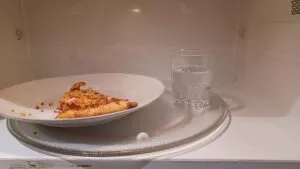
Source: Rank-It.ca
I decided to try putting a cup of water in the microwave with the pizza. After microwaving the two for a minute and a half, I didn’t notice any improvement in the quality of the pizza. The slice was still limp and soggy, and the crust was extremely chewy. There was also lots of excess grease. A lot of napkins were needed, and I almost had to use a knife and fork to eat the pizza. The cheese, sauce, and toppings were the only things that tasted alright. But as you can see in the following photo, the cheese didn’t melt that well.

Source: Rank-It.ca
The microwave is definitely the quickest way to reheat pizza. If you can’t wait to eat that leftover slice, then this method is for you. But if you want a crispy, chewy, flavourful piece of pizza, avoid this method at all costs. Some of the original taste and texture will still be there, but it pales in comparison to the quality of a fresh piece of pizza.
The oven
Ovens are seen as the best way to reheat leftover pizza. I’ve never tried this approach myself, but I know people who have. My brother usually place the pizza directly onto the oven rack and bakes it at 350˚F for 5-7 minutes. This process works for him
To test this method, I followed the steps laid out by Cook’s Illustrated. Place the pizza in a rimmed baking sheet and cover it tightly with aluminum foil. Before you heat up the oven, place the sheet on the lowest rack. Then set the oven to 275˚F. Leave the sheet in for 25-30 minutes. The pizza should be done when the bottom is crisp and the cheese has melted. The benefit of this approach is that the pizza gradually warms up, which gives it plenty of time to release the moisture. You’ll end up with a slice that is nice and soft without being too soggy. Sealing the pan prevents the pizza from drying out. Plus, placing the pan on the bottom rung lets the underside of the pizza crispen without the toppings shrivelling up.
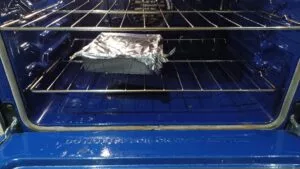
Source: Rank-It.ca

Source: Rank-It.ca
Reheating pizza in the oven was a big improvement over the microwave approach. As soon as lifted the tinfoil cover, I knew the oven effectively reheated the pizza. The slices were soft and doughy, but they were still crisp and firm. The toppings held up well under the heat. The cheese melted evenly, the pepperoni and ham didn’t shrivel up, and the tomato sauce retained its moist texture. The grease level was minimal, and the sogginess was completely eliminated. One downside to this method is that it is inefficient to use an oven to reheat a single slice of pizza. Ovens are best used to heat up either a half or whole pizza pie. If you only want to reheat one or two slices, a toaster oven would be a better option. While this method did require lots of patience, but the result is worth the wait.
The skillet
Prior to writing this article, I had never thought to reheat pizza in a skillet. It seems unorthodox, but several cooking websites say that it is the best way to heat up leftover slices. Before you begin, I recommend using a non-stick pan. Since this method does not require oil, the slice goes directly on the pan. There’s a greater risk of the slice welding itself to the skillet. Cast iron skillets are a good option, and they evenly disperse heat. Stainless steel skillets are good as well.
According to Food52, place the slice in the skillet and heat on medium-low for 2-3 minutes. Once the bottom is crisp, add a few drops of water to skillet. Make sure to place the drops away from the pizza. Turn the heat to low and cover the skillet with a lid. The water will start evaporating and the steam will melt the cheese. Let it sit for 1-2 minutes. You should get a slice with gooey cheese, a moist crust, and a crunchy bottom. You can also use a piece of tin foil to cover the skillet. And as a bonus, lifting the foil or lid off the skillet will give a nice warm blast of delicious pizza aroma.
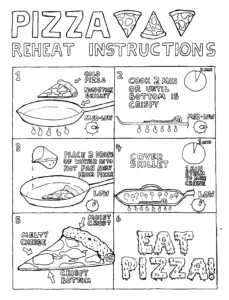
The skillet process according to Food52. Source: Food52
This method was the best one by a longshot. The slice tasted like it was freshly made. The crust was nice and crispy, with the bottom having an incredible crunch. The pizza had the right amount of moisture and grease. The real secret behind this method’s success is adding the water droplets. It melts the cheese perfectly and gives it a gooey texture.

Source: Rank-It.ca
The drawbacks for this method were very minor. You can only reheat one or two slices at a time, depending on the size of the skillet. It also took me longer to heat up my slice (about six minutes). However, I’m willing to overlook these cons after tasting the reheated pizza.
I can safely say that reheating pizza on a skillet with a dash of water is a flawless approach. The flavour and texture of a freshly made slice is impeccably recreated. I definitely plan on using this method from now on.
Other methods
The air fryer
Air fryers are essentially small convection ovens. They cook food by circulating hot air around it. Air fryers are mostly used to cook French fries, onion rings, and other fried foods. Using them to reheat pizza was something I had never considered before. But according to Easy Healthy Recipes, there are several benefits to using an air fryer to reheat pizza:
- Compared to ovens or skillets, air fryers are quicker at heating up slices. The preheating time is faster, which means you can start reheating sooner.
- Since air fryers use less oil in cooking, there is less mess to clean up. You also don’t have to deal with baking sheets or tin foil.
- An air fryer is guaranteed to keep the pizza crispy.
- Any kind of pizza can be reheated in an air fryer, e.g., thick or thin crust, deep dish, frozen, homemade.
Dutch Ovens Cookware recommends setting your air fryer to 320˚F and cooking the pizza for 3-4 minutes. Place the slices evenly in the baskets and do not overlap them. Another tip is to reheat similar slices together. This ensures that the slices will heat up at the same pace. Reheating a thin slice with a thick one will cause uneven heating. The large slice will take longer to reheat, while the smaller one will burn up by the time the thick piece is ready.
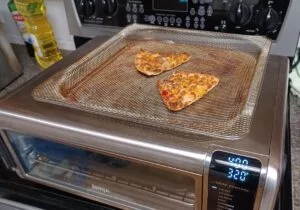
Source: Rank-It.ca

Source: Rank-It.ca
The results were on par with the oven method. The sauce, cheese, and toppings all heated well. The slices tasted like they were freshly baked. However, the pizza turned out crispier in the air fryer. Plus, this method was extremely quick and required no clean up. Multiple slices can also be reheated at the same time, although you’ll have to do them in batches (e.g., 2-3 slices at a time). One thing I had to be mindful of was overcooking, which means a burnt slice of pizza. I’ve read other articles which say that this method is not effective. Some people say the air fryer produces the same results as the microwave: a limp pizza slice. It may depend on the air fryer you use. I used the Ninja Foodi air fry oven, and it did the trick. The results may have changed if I used a different model.
The grill
I vaguely remember hearing about this method before, but I never had the chance to try it out. You can find many versions for this method online. A popular example is to preheat the grill to medium-high heat (around 400-425˚). Next, throw the pizza directly onto the grate, no oil is needed. Let the pizza cook for 6-10 minutes. Once the cheese starts to bubble and the crust feels crispy, the pizza is ready.
Unfortunately, I was unable to try out this method. But judging from other people’s experience, the grill does a good job of heating up cold pizza. However, it’s not the most convenient method. If you only want to reheat a single slice, setting up your grill does not seem worth it. It’s also a waste of propane reheating 1-2 slices. And if it’s raining or it’s extremely cold, grilling leftover pizza will be an unpleasant experience. I would not use this method in the middle of winter when the temperature could hit -30˚C with the wind chill.
Conclusion

Source: Rank-It.ca
After testing out each method, using a skillet is the best way to reheat pizza. The slice had evenly melted cheese, crispy toppings, and a crunchy crust. It tasted like a freshly baked piece of pizza; not too soggy but not too dry either. And just from a visual standpoint, the pizza looked delicious. I recommend everyone try this method. You’ll never want to eat a cold leftover slice ever again. The oven and the air fryer were also effective methods. If you want to reheat a half or whole pizza, the oven is the way to go. If there was one method I would not recommend, it would be the microwave. It might be great if you’re in a rush, but it will turn your pizza into a soggy, limp, and oily mess.
Overall, this was an informative and fun experiment. If I ever find myself with leftover pizza, I now know the best ways to reheat them.
Frequently asked questions about reheating pizza
What is the best way to store leftover pizza?
The general rule of thumb is to keep those leftover slices refrigerated. Leaving leftover pizza out overnight runs the risk of the cheese and other toppings spoiling. There’s a greater chance of you getting sick from a foodborne illness if you eat an unrefrigerated slice. Besides refrigeration, there are several ways to store leftover pizza. Some people simply leave it in the delivery box. However, the box may not fit in the fridge if it’s already full. Plus, the box lets in air. This dries out the crust and makes it tough. My method has always been putting the leftovers in a large Tupperware container. I’ve been using this approach for several years, and it has always kept the leftover pizza fresh. But I run into issues when my fridge gets crowded; trying to find space for the large container can be a challenge.

The stack and seal method. Source: Rank-It.ca
According to Kitchn, the best way to store leftover pizza is to stack and seal. What they means is to stack the slices on top of each other and place it in a resealable bag or wrap it in plastic wrap. Both of these methods save space and keep your pizza from drying out.
How long is leftover pizza good for?
If you’ve ever been left with a ton of pizza leftovers, you may have asked yourself, how long are they good for? In other words, how long can you keep eating slices before they spoil. I’ve often asked this question and have never come up with a definitive answer. In general, pizza should not be left out for more than two hours at room temperature. Bacteria tends to grow quickly on food when its temperature is between 40-140˚F (it’s often called the danger zone). As I mentioned earlier, storing pizza in the fridge will help it last longer. Most sources say that refrigerated pizza should last 3-4 days in an airtight container. Any longer than that and you run the risk of your pizza spoiling. Freezing pizza is actually a good way of making pizza last longer. Frozen pizza can last up to three months, and it will retain its delicious flavour.
Why does leftover pizza go soggy?
A common complaint of leftover pizza is that it gets soggy. The crust loses its crispy texture, and the entire slice becomes a sloppy mess. The reason why pizza becomes soggy is because there is too much moisture. Normally, the moisture evaporates from the crust during the baking process. But once leftover slices are put in the fridge, the moisture can return. To get rid of the moisture, you need to reheat your pizza longer and at a higher temperature. That’s why putting it in the microwave for a few minutes is not the best approach. The microwave does not have enough heat to fully reheat your pizza. And chances are you don’t want to run your microwave for 15 plus minutes in order to fully crispen your leftover slices. The oven or skillet are much better methods for getting rid of moisture. They produce enough heat, and you can reheat them for longer durations.
Sources used:
Kitchn: The Best Way to Reheat Pizza
Read more

The Best Instant Pots in Canada
If you’re a cooking enthusiast, check out our buying guide on the best Instant Pots in Canada.
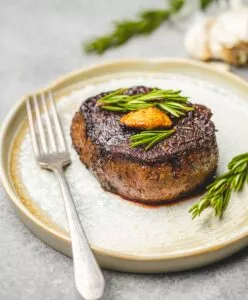
The Best Sous-Vide Machines in Canada
Cook a juicy steak everytime like a gourmet chef with this selection of sous-vide machines.

The Best Canadian Vodka
Canadian vodka is a unique spirit. Here are some of the best brands.

The Best Coffee Brands & Roasters in Canada
You no longer need to get lost in coffee culture with this ultimate guide for Canadians.